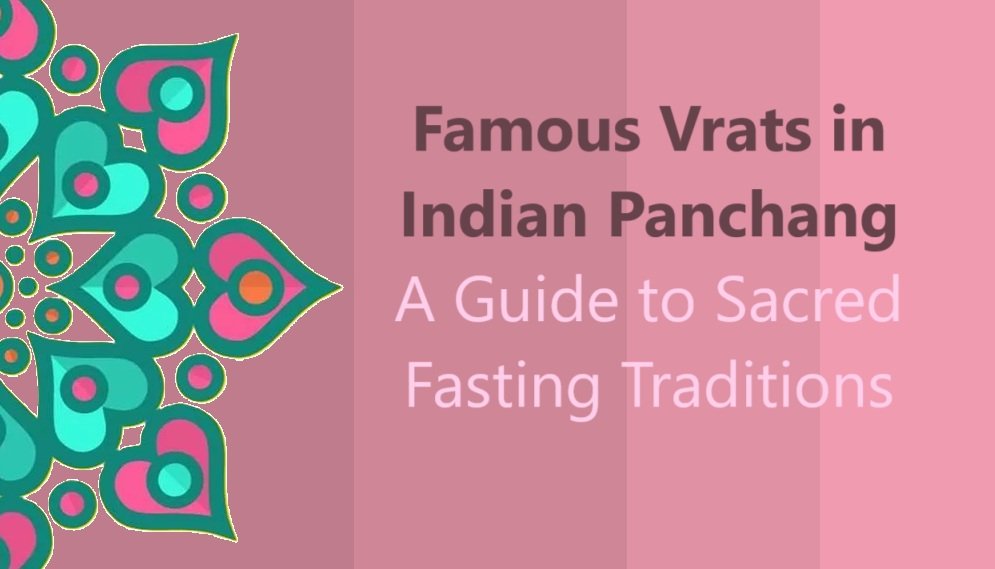
Famous Vrats in Indian Panchang: Dates and Significance
In Hinduism, vrat (व्रत) or fasting is a sacred observance performed for spiritual purification, devotion, and the fulfillment of desires. The Indian Panchang (Hindu calendar) lists several important vrats, each with unique significance and rituals. These vrats are observed based on the tithi (lunar day), nakshatra (constellation), and planetary positions. Below is a detailed guide to some of the most famous vrats in the Hindu calendar.
1. Ekadashi Vrat (एकादशी व्रत)
- When: Twice a month (Shukla Paksha and Krishna Paksha Ekadashi)
- Deity Worshipped: Lord Vishnu
- Significance: Observed for spiritual cleansing and attaining moksha (liberation).
- Rituals: Devotees abstain from grains, consume fruits and milk, chant Vishnu Sahasranama, and stay awake at night.
- Famous Ekadashi:
- Vaikuntha Ekadashi (December/January) – Most auspicious, opens the gates of Vaikuntha (Vishnu’s abode).
- Nirjala Ekadashi (June) – Strictest form of fasting without water.
Read This: Ekadashi 2025: Dates, Significance, Rituals, and Benefits
2. Pradosh Vrat (प्रदोष व्रत)
- When: Twice a month (Trayodashi tithi – 13th lunar day)
- Deity Worshipped: Lord Shiva
- Significance: Helps remove sins and grants prosperity.
- Rituals: Observers fast from sunrise to sunset and perform Shiva puja during the evening twilight.
Read This: Pradosh Vrat 2025: Dates, Significance, and Observance
3. Purnima Vrat (पूर्णिमा व्रत)
- When: On every full moon day
- Deity Worshipped: Lord Vishnu, Goddess Lakshmi, and various deities
- Significance: Enhances spiritual and material well-being.
- Rituals: Fasting, offering prayers to the Moon, and performing Satyanarayan Puja.
- Famous Purnima Vrats:
- Guru Purnima (July) – Dedicated to spiritual gurus.
- Sharad Purnima (October) – Observed for health and wealth.
4. Amavasya Vrat (अमावस्या व्रत)
- When: On every new moon day
- Deity Worshipped: Lord Shiva and ancestors (Pitru Devatas)
- Significance: Ideal for ancestor worship and removing negative energies.
- Rituals: Tarpan (offering water to ancestors), fasting, and visiting temples.
- Famous Amavasya Vrats:
- Mahalaya Amavasya (September/October) – Observed for Pitru Tarpan.
- Somvati Amavasya – Falls on a Monday, believed to be highly auspicious.
5. Sankashti Chaturthi Vrat (संकष्टी चतुर्थी व्रत)
- When: On the 4th day after the full moon (Krishna Paksha Chaturthi)
- Deity Worshipped: Lord Ganesha
- Significance: Removes obstacles and fulfills wishes.
- Rituals: Devotees fast the entire day and break it after moonrise by worshipping Ganesha.
- Special Sankashti Chaturthi: Angarki Chaturthi (falls on Tuesday) is the most powerful.
6. Saptami Vrat (सप्तमी व्रत)
- When: On the 7th lunar day (Saptami tithi)
- Deity Worshipped: Lord Surya (Sun God)
- Significance: Bestows health, strength, and success.
- Famous Saptami Vrat:
- Ratha Saptami (January/February) – Celebrates the Sun’s chariot moving toward the northern hemisphere.
7. Navratri Vrat (नवरात्रि व्रत)
- When: Twice a year – Chaitra Navratri (March/April) & Sharad Navratri (September/October)
- Deity Worshipped: Goddess Durga
- Significance: Invokes divine blessings for strength and prosperity.
- Rituals: Fasting, reciting Durga Saptashati, and performing Kanya Pujan.
Explore this:
- Chaitra Navratri 2025: Dates, Significance, Rituals, and Cultural Importance
- Chaitra Navratri 2025: Wishes, Messages, and Quotes
- Ghatasthapana Puja Vidhi during Navratri
8. Karwa Chauth (करवा चौथ)
- When: Krishna Paksha Chaturthi (October/November)
- Deity Worshipped: Lord Shiva, Goddess Parvati, and the Moon
- Significance: Observed by married women for their husbands’ longevity.
- Rituals: Nirjala (without water) fasting until moonrise, followed by offerings to the Moon.
9. Vat Savitri Vrat (वट सावित्री व्रत)
- When: Jyeshtha Amavasya (May/June)
- Deity Worshipped: Goddess Savitri and Lord Brahma
- Significance: Observed by married women for their husbands’ well-being.
- Rituals: Fasting, tying sacred threads around a banyan tree, and reciting the Savitri-Katyayani Katha.
10. Chhath Puja (छठ पूजा)
- When: Kartik Shukla Shashthi (October/November)
- Deity Worshipped: Lord Surya and Chhathi Maiya
- Significance: Famous in Bihar, Uttar Pradesh, and Nepal; performed for gratitude and family prosperity.
- Rituals: Four-day fasting, offering Arghya to the Sun during sunrise and sunset.
The tradition of vrats in Hinduism is deeply rooted in devotion, discipline, and spiritual growth. Observing these vrats with sincerity is believed to bring peace, prosperity, and divine blessings. Whether it’s Ekadashi for Lord Vishnu, Sankashti for Lord Ganesha, or Navratri for Goddess Durga, each vrat has its own sacred importance in the Indian Panchang.
By following these vrats, devotees not only strengthen their spiritual connection but also uphold ancient customs that have been passed down for generations. 🙏